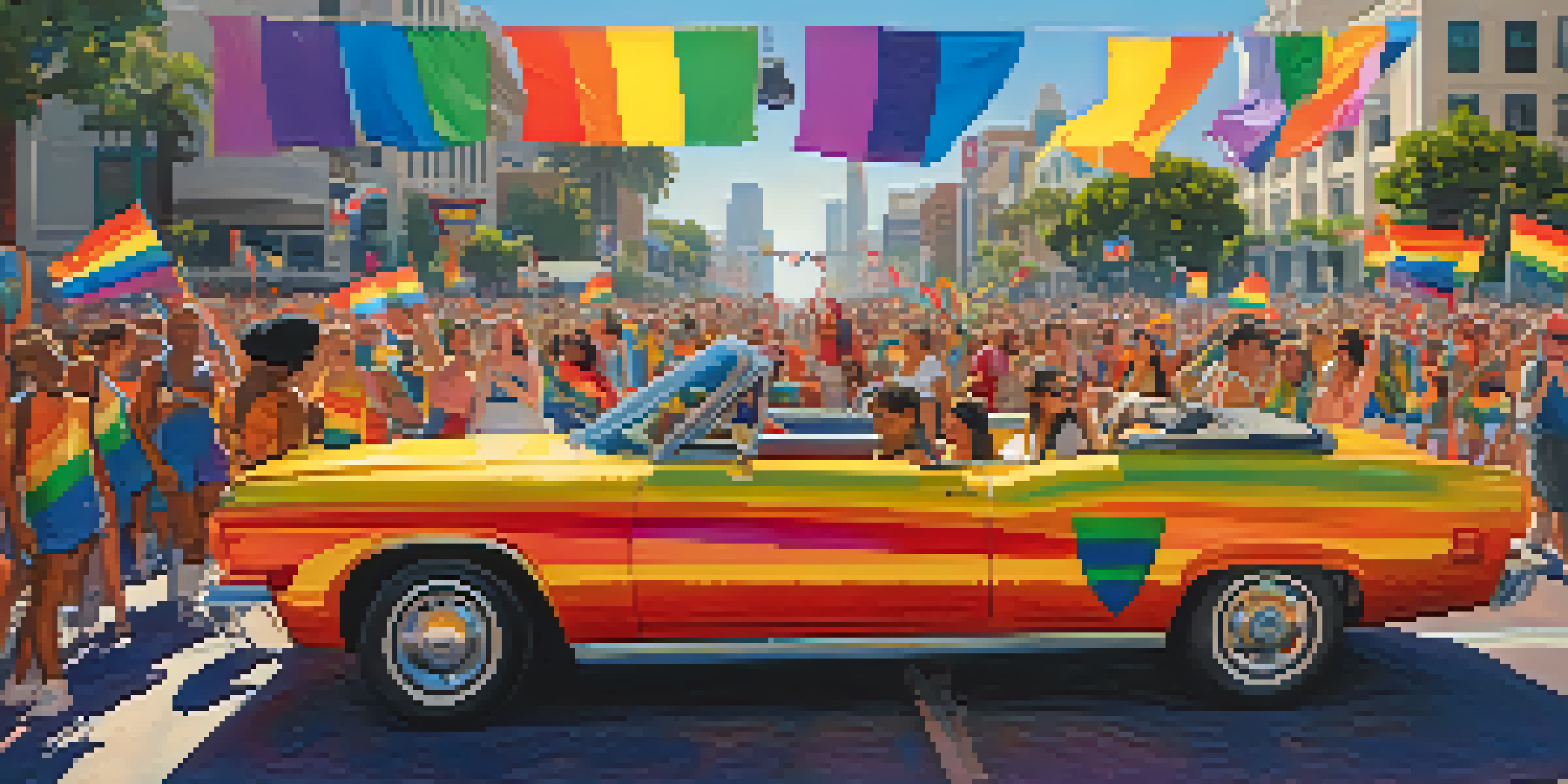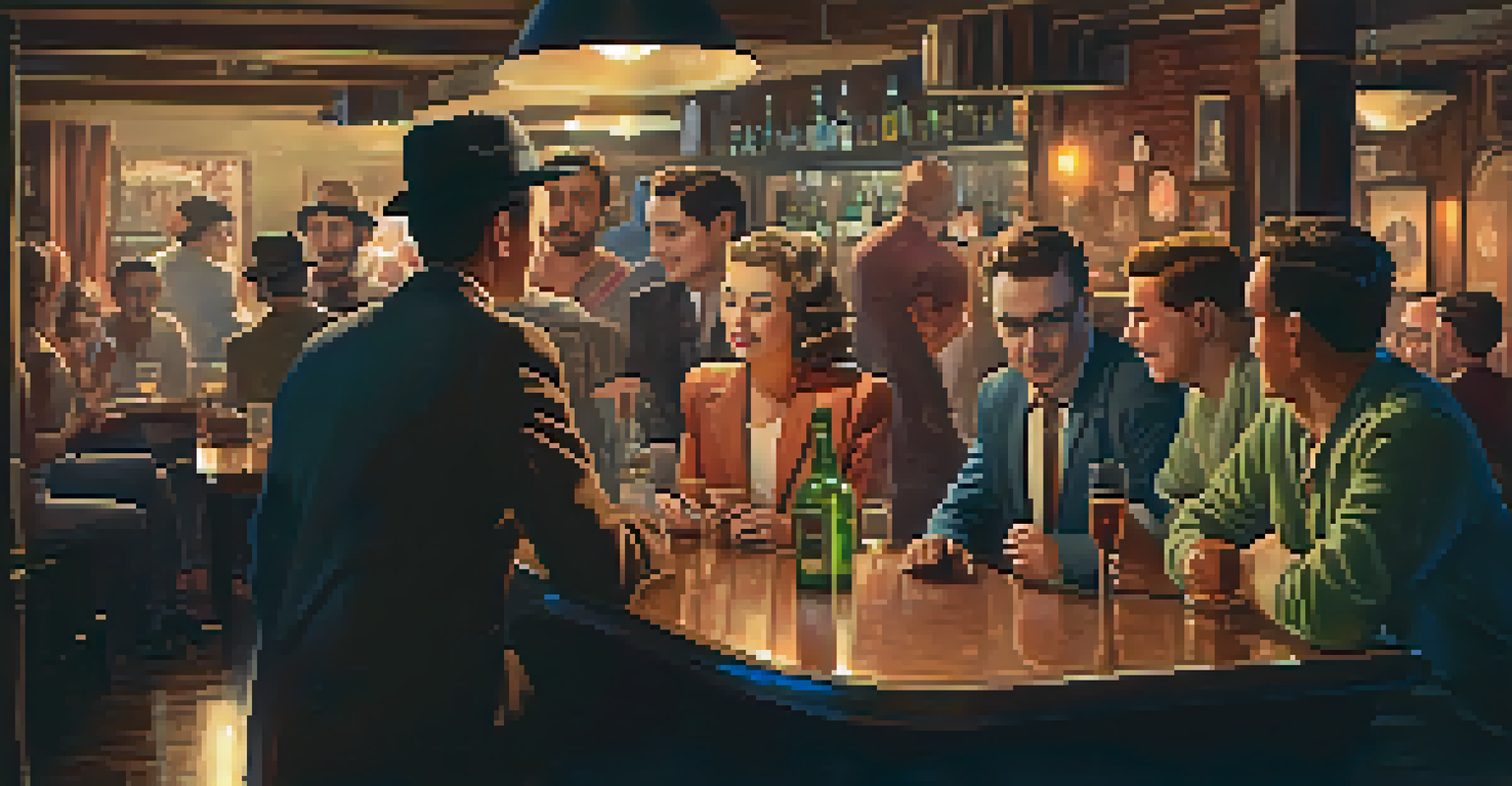The Evolution of LGBTQ+ Rights in Los Angeles: A Historical Overview

Early Struggles: The 20th Century Begins
The fight for LGBTQ+ rights in Los Angeles began in the early 20th century, a time when homosexuality was largely stigmatized. Social norms were rigid, and individuals faced severe discrimination and criminalization. Despite the challenges, small communities began to form, laying the groundwork for future activism.
Injustice anywhere is a threat to justice everywhere.
In the 1940s and 1950s, the city witnessed the emergence of underground bars and clubs where LGBTQ+ individuals could gather, albeit with the constant threat of police raids. These venues became safe havens for expression, leading to the creation of an early gay subculture. Activism was nascent but began to take root as individuals sought visibility and acceptance.
The post-war period marked a significant turning point, as returning veterans began to question societal norms. The seeds of change were being sown, setting the stage for a more organized movement in the coming decades.
The Stonewall Effect: Activism Takes Shape
The 1969 Stonewall Riots in New York City ignited a wave of activism across the nation, including Los Angeles. Inspired by these events, local groups began organizing protests and advocating for LGBTQ+ rights. The city became a focal point for the burgeoning gay rights movement, with events like the first Gay Pride Parade in 1970.

Activists in Los Angeles formed organizations such as the Gay Liberation Front and the Christopher Street West, which played pivotal roles in raising awareness and pushing for change. These groups fought for basic civil rights, including decriminalization of homosexuality and anti-discrimination laws. Their efforts were met with both support and resistance, reflecting the divided attitudes of the time.
LGBTQ+ Rights Evolve Through Activism
Grassroots movements in Los Angeles laid the foundation for LGBTQ+ rights, particularly following pivotal events like the Stonewall Riots.
The momentum generated in the early '70s was crucial. It not only mobilized the LGBTQ+ community but also educated the public about the struggles they faced, fostering a growing sense of solidarity and purpose.
The AIDs Crisis: A Catalyst for Change
The emergence of the AIDS crisis in the 1980s had a profound impact on the LGBTQ+ community in Los Angeles. As the epidemic claimed countless lives, it galvanized activists and allies to demand urgent action from both the government and society. The crisis underscored the vulnerability of the community and the dire need for healthcare and support.
The only way to deal with discrimination is to expose it, to bring it out into the open, and to make it unacceptable.
Organizations like ACT UP and the AIDS Project Los Angeles mobilized resources, raised awareness, and fought for treatment options, making the crisis a focal point of activism. Their tireless advocacy not only highlighted the injustices faced by those living with HIV/AIDS but also demanded recognition and respect for LGBTQ+ lives.
In the face of tragedy, the community united, creating bonds that would last well beyond the crisis. This period marked a shift from marginalization to a more organized and assertive movement, pushing for not only medical solutions but also broader societal acceptance.
Legal Milestones: Progress in the Courts
The 1990s and 2000s saw significant legal advancements for LGBTQ+ rights in Los Angeles. Landmark cases began to emerge, challenging discriminatory laws and practices. One notable victory was the California Supreme Court's ruling in 2008 that allowed same-sex marriage, a milestone celebrated by many.
These legal victories were often the result of years of hard-fought activism. LGBTQ+ organizations worked tirelessly to influence legislation, leading to the eventual passage of laws protecting against discrimination based on sexual orientation and gender identity. The legal landscape began to shift, reflecting growing acceptance in society.
AIDS Crisis Sparks Urgent Advocacy
The 1980s AIDS crisis galvanized the LGBTQ+ community and allies, highlighting the need for healthcare and societal recognition.
As the legal framework evolved, so did public perception. Increased visibility of LGBTQ+ individuals in media and culture played a crucial role in normalizing diverse identities, helping to foster a more inclusive environment in Los Angeles.
Cultural Representation: Visibility Matters
Cultural representation has played an essential role in the evolution of LGBTQ+ rights in Los Angeles. The rise of LGBTQ+ artists, filmmakers, and writers brought diverse narratives to mainstream media, challenging stereotypes and fostering empathy. Events like the Los Angeles LGBTQ+ Film Festival became platforms for showcasing these voices.
Television shows and movies began to feature LGBTQ+ characters and storylines, reflecting the community's experiences and struggles. This visibility was crucial in changing perceptions and combating discrimination, as audiences were exposed to authentic representations of LGBTQ+ lives.
The cultural shift towards acceptance was not just about entertainment; it was a vital part of the broader movement for equality. As society became more familiar with LGBTQ+ stories, it paved the way for increased advocacy and support from allies.
Ongoing Challenges: The Fight Continues
Despite significant progress, challenges remain for the LGBTQ+ community in Los Angeles. Issues such as homelessness among LGBTQ+ youth, discrimination in healthcare, and violence against transgender individuals are ongoing concerns. These challenges serve as reminders that the fight for equality is far from over.
Activists continue to advocate for comprehensive protections and support systems. Organizations work tirelessly to address these issues, emphasizing the importance of intersectionality in the movement. They recognize that the LGBTQ+ experience is not monolithic and that diverse voices must be heard.
LGBTQ+ Activism Emerges in LA
The early 20th century saw the formation of LGBTQ+ communities in Los Angeles, laying the groundwork for future activism despite severe social stigma.
The resilience of the community is evident as they confront these challenges head-on. The ongoing activism and solidarity among individuals and organizations highlight the commitment to achieving full equality for all.
Celebrating Achievements: Pride and Progress
Today, Los Angeles stands as a beacon of progress for LGBTQ+ rights, with annual events like the LA Pride Parade drawing hundreds of thousands of participants. These celebrations not only honor the history of the movement but also highlight the ongoing struggle for equality. Pride events serve as a reminder of the community's resilience and achievements.
The evolution of LGBTQ+ rights in Los Angeles has inspired many to continue the fight for justice and acceptance. The city has become a model for other regions, showcasing how activism, culture, and community can drive change. Each achievement is a testament to the hard work and dedication of those who came before.

As we reflect on this journey, it's clear that while significant strides have been made, the fight for LGBTQ+ rights is ongoing. Celebrating achievements is essential, but it also fuels the motivation to address the challenges that remain, ensuring that all identities are respected and embraced.